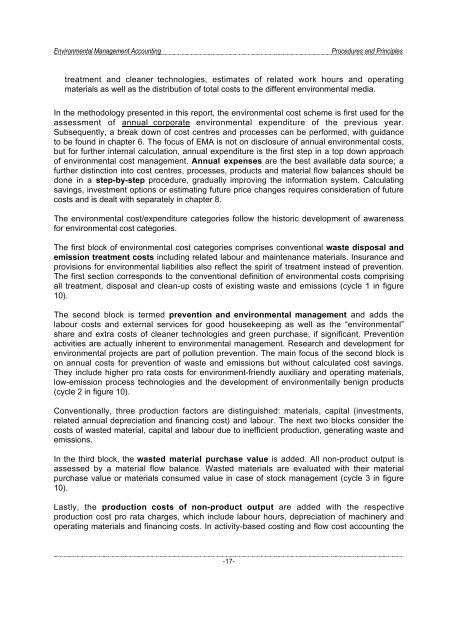Environmental Management Accounting Procedures and Principles
Environmental Management Accounting Procedures and Principles
Environmental Management Accounting Procedures and Principles
Create successful ePaper yourself
Turn your PDF publications into a flip-book with our unique Google optimized e-Paper software.
<strong>Environmental</strong> <strong>Management</strong> <strong>Accounting</strong><br />
<strong>Procedures</strong> <strong>and</strong> <strong>Principles</strong><br />
treatment <strong>and</strong> cleaner technologies, estimates of related work hours <strong>and</strong> operating<br />
materials as well as the distribution of total costs to the different environmental media.<br />
In the methodology presented in this report, the environmental cost scheme is first used for the<br />
assessment of annual corporate environmental expenditure of the previous year.<br />
Subsequently, a break down of cost centres <strong>and</strong> processes can be performed, with guidance<br />
to be found in chapter 6. The focus of EMA is not on disclosure of annual environmental costs,<br />
but for further internal calculation, annual expenditure is the first step in a top down approach<br />
of environmental cost management. Annual expenses are the best available data source; a<br />
further distinction into cost centres, processes, products <strong>and</strong> material flow balances should be<br />
done in a step-by-step procedure, gradually improving the information system. Calculating<br />
savings, investment options or estimating future price changes requires consideration of future<br />
costs <strong>and</strong> is dealt with separately in chapter 8.<br />
The environmental cost/expenditure categories follow the historic development of awareness<br />
for environmental cost categories.<br />
The first block of environmental cost categories comprises conventional waste disposal <strong>and</strong><br />
emission treatment costs including related labour <strong>and</strong> maintenance materials. Insurance <strong>and</strong><br />
provisions for environmental liabilities also reflect the spirit of treatment instead of prevention.<br />
The first section corresponds to the conventional definition of environmental costs comprising<br />
all treatment, disposal <strong>and</strong> clean-up costs of existing waste <strong>and</strong> emissions (cycle 1 in figure<br />
10).<br />
The second block is termed prevention <strong>and</strong> environmental management <strong>and</strong> adds the<br />
labour costs <strong>and</strong> external services for good housekeeping as well as the “environmental”<br />
share <strong>and</strong> extra costs of cleaner technologies <strong>and</strong> green purchase, if significant. Prevention<br />
activities are actually inherent to environmental management. Research <strong>and</strong> development for<br />
environmental projects are part of pollution prevention. The main focus of the second block is<br />
on annual costs for prevention of waste <strong>and</strong> emissions but without calculated cost savings.<br />
They include higher pro rata costs for environment-friendly auxiliary <strong>and</strong> operating materials,<br />
low-emission process technologies <strong>and</strong> the development of environmentally benign products<br />
(cycle 2 in figure 10).<br />
Conventionally, three production factors are distinguished: materials, capital (investments,<br />
related annual depreciation <strong>and</strong> financing cost) <strong>and</strong> labour. The next two blocks consider the<br />
costs of wasted material, capital <strong>and</strong> labour due to inefficient production, generating waste <strong>and</strong><br />
emissions.<br />
In the third block, the wasted material purchase value is added. All non-product output is<br />
assessed by a material flow balance. Wasted materials are evaluated with their material<br />
purchase value or materials consumed value in case of stock management (cycle 3 in figure<br />
10).<br />
Lastly, the production costs of non-product output are added with the respective<br />
production cost pro rata charges, which include labour hours, depreciation of machinery <strong>and</strong><br />
operating materials <strong>and</strong> financing costs. In activity-based costing <strong>and</strong> flow cost accounting the<br />
-17-




